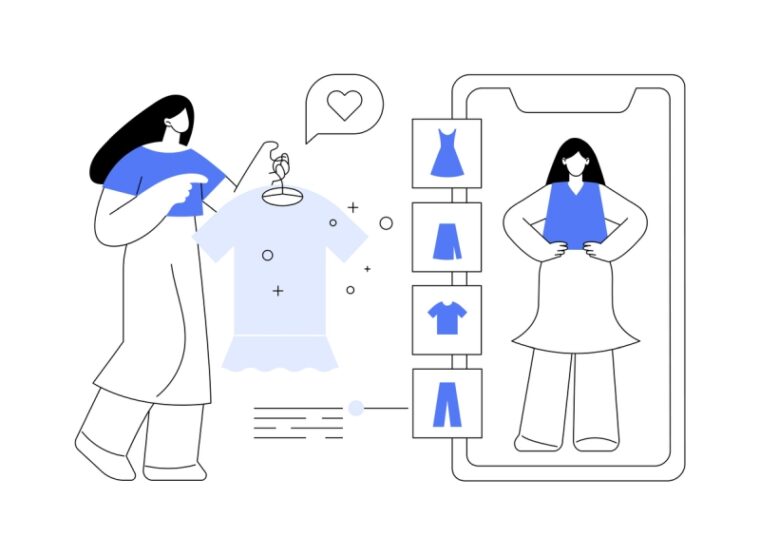In the eCommerce landscape, Artificial Intelligence (AI) is reshaping the game. This blog series explores how AI’s intelligent algorithms are revolutionizing online businesses, from personalized product recommendations to efficient inventory management. Join us for insights on leveraging AI to enhance the digital shopping experience and overall success in eCommerce.
Experimenting with generative artificial intelligence like ChatGPT may rather quickly lead to faster and more creative text ‘writing’, but the technology harbours many more opportunities for ecommerce. However, not without risk. Therefore, a look at strategy and concrete examples is in order.
Firstly, the phrase ‘AI is everywhere’ has become quite common in tech and ecommerce. Although it is debatable what is considered AI and what is not (for example, more advanced ‘if this, then that’ rules, which can also be executed in Excel), it is worth noting that in this article, we are looking at generative AI. These are the large language model (LLM)-based tools that compute and display the most logical answers to commands/prompts.
From ChatGPT and Bard to Midjourney and Craiyon, a recent report by McKinsey & Company once again underlines that generative AI will boost productivity in many sectors. In (online) retail, the greatest impact is in marketing, sales and customer contact, according to the consultancy. This extends to software development as well.
‘By automating repetitive tasks, agents can spend more time handling complex issues.’ Retailers can, for example, combine existing AI tools with generative AI to enhance the capabilities of chatbots, allowing them to better mimic the interaction style of human employees. These capabilities include responding directly to a customer’s query, tracking or cancelling an order, offering discounts and upselling. Moreover, by automating repetitive tasks, human agents can spend more time handling complex customer issues and obtaining contextual information.
Retailers can, for example, combine existing AI tools with generative AI to enhance the capabilities of chatbots, allowing them to better mimic the interaction style of human employees. These capabilities include responding directly to a customer’s query, tracking or cancelling an order, offering discounts and upselling. Moreover, by automating repetitive tasks, human agents can spend more time handling complex customer issues and obtaining contextual information.
Ruti, a womenswear brand based in New York, implemented an AI tool from Feel, which utilizes ChatGPT. This tool is designed to assist three virtual sales associates and is initially trained with standard customer inquiries from its affiliated brands. Once integrated, it begins to learn from its interactions with customers. For instance, a customer might ask, “Can you recommend a purple evening outfit?” In response, the virtual assistant, backed by AI, provides answers to style-related questions and suggests suitable items from the product catalogue.
Ruti had an increase in conversion rates after implementing an AI tool, from 54% to 57%.
According to the company, the brand witnessed an increase in its conversion rates, from 54.3 percent in the latter half of 2022 to 57.2 percent in the first half of this year. Additionally, the average order values rose from 54.4 percent to 59 percent during the same timeframe.
Larger companies are also exploring this domain. Zalando will soon introduce a first beta version of a new fashion assistant, powered by ChatGPT, in the app and on the website, aiming to improve customer experience and perception on the website.
For example, if a customer asks what he or she could wear to a wedding in Spain during spring, Zalando’s fashion assistant can understand that it is a formal event, predict the weather at the time and provide an explanation with clothing recommendations based on that. The future aim is to combine this with customer preferences, such as the brands they follow and products available in their sizes, to present a more personalised selection of products.
For its part, Google recently launched a tool to give consumers a better idea of the clothes they buy online. U.S. shoppers can virtually try on women’s tops from brands across Google, including Anthropologie, Everlane, H&M and LOFT. Why? Forty-two percent of online shoppers do not feel represented by images of models, and fifty-nine percent feel dissatisfied with an item they shopped for online because it looked different on them than expected, argues the search giant.
With a virtual try-on, customers can see how clothes look on a variety of models.
The virtual try-on for apparel shows you how clothes look on a variety of real models. The new generative AI model can take just one clothing image and accurately reflect how it would drape, fold, cling, stretch, and form wrinkles and shadows on a diverse set of real models in various poses. The company selected people ranging in sizes XXS-4XL, representing different skin tones, body shapes, ethnicities, and hair types.
But it does not end here. The new guided refinements can help shoppers fine-tune products until they find the perfect piece. Thanks to machine learning and new visual matching algorithms, consumers can refine using inputs like colour, style, and pattern. And unlike shopping in a store, they are not limited to one retailer. The tool displays options from stores across the web.
McKinsey cites that generative AI tools can enhance the process of developing new versions of products by digitally creating new designs rapidly. A designer can generate packaging designs from scratch or create variations on an existing design. This technology is developing rapidly and has the potential to add text-to-video generation.
‘By creating content at a lower cost, you can make more variations.’
In line with this, a new consultancy company used ChatGPT and Midjourney to create hyperrealistic images of actual recipes from Dutch supermarket chain Albert Heijn’s store magazine Allerhande. “I spent 0 euros and created these images in less than 1 minute”, says creator Wouter van Haaften. By creating content much quicker and at a much lower cost, you can make many more variations, allowing you to A/B test at scale, he further explains. “This will help optimise your (marketing) KPIs, eventually driving significant ROI.” The trick is accurate communication with the AI models, he concludes.
Yet, deploying generative AI is not without risk, McKinsey underscores. As retail and CPG executives explore how to integrate generative AI into their operations, they should keep in mind several factors that could affect their ability to capture value from the technology. Generative AI has increased the need to understand whether generated content is based on fact or inference, requiring a new level of quality control.
Companies need to institute more detailed quality checks on AI-assisted processes.
Companies will need to institute new quality checks for processes previously handled by humans, the consultancy finds. These include emails written by customer reps. They will also need to perform more detailed quality checks on AI-assisted processes such as product design.
Taking this into account, further opportunities for generative AI in ecommerce are already emerging. For example, the development of ‘automatically’ generated virtual worlds. By combining different tools, such as Metaverse creator Ilumine AI and image generator Midjourney, it is possible to create a virtual space within a short time. For now, these experiments are mainly taking place in the gaming world, but a translation to an online shopping environment is by no means inconceivable.
Retailers should look into improving customer experience based on textual adjustments.
However, for those who feel this is still too far out of reach – various studies indicate that retailers currently need to pay attention to other things, such as the cost crisis and other financial pressures – it is advisable to look, like Amazon, at how to improve user experiences based on textual adjustments. Amazon is summarizing reviews using AI, turning all reviews for each product into a few sentences that best describe consumer feedback.
And that touches on the general benefit of generative artificially intelligent systems: you can ask tools to perform tasks the way you would ask a fellow human to do them. Getting the prompt right takes time and is a matter of trial and error. Fortunately, there are many tips and examples already available for free.
Ecommerce News is a website made by Eurolutions. All articles are written by our own editorial staff.
Sign up for our free email newsletter and make sure that you never miss the latest updates from Ecommerce News!
Receive our latest news directly in your mailbox to stay up to date.
Ecommerce News Europe is a news website by online publisher Eurolutions. Read more about us or view our advertising options.
Online publisher Eurolutions
Molensteyn 60-B
3454 PT De Meern
The Netherlands
Email: info@ecommercenews.eu
KvK: 37102174
VAT: NL002097294B45
© Copyright 2002-2024 – Online publisher Eurolutions
This website uses cookies.
